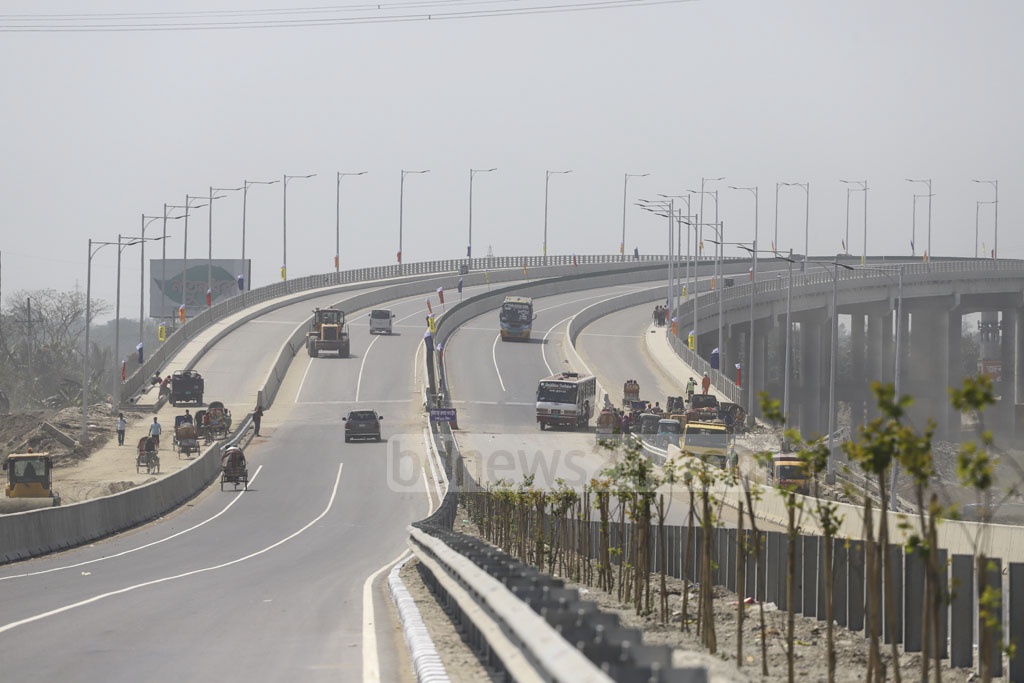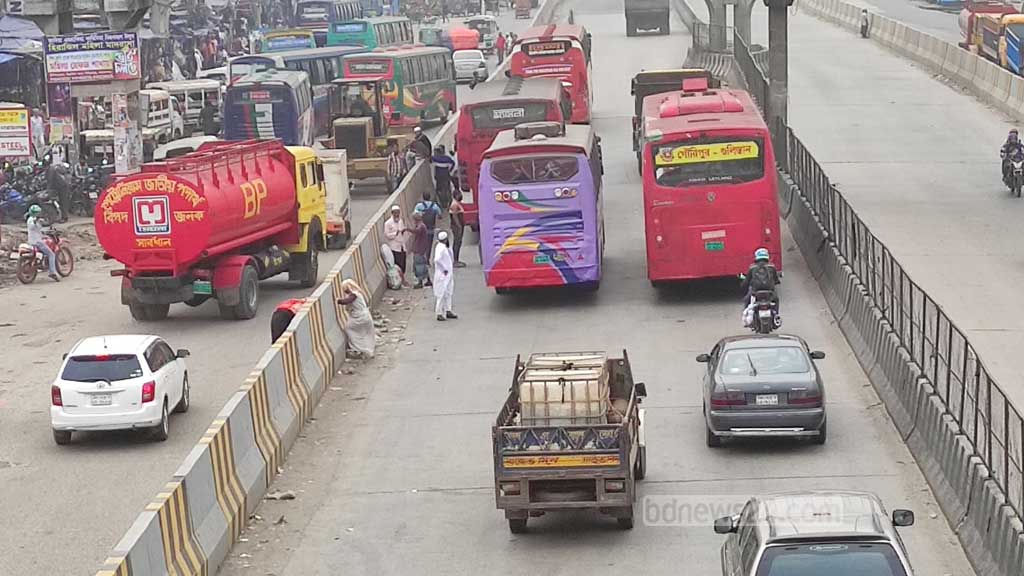Home
+
Experts and transportation stakeholders argue that the government's set vehicle speed limits lack both scientific justification and feasibility

Published : 15 May 2024, 03:44 AM
Experts find the speed limits on vehicles designed to curb accidents challenging to implement.
Most objections are directed at the maximum speed limit of 30 kilometres per hour within city corporation areas, with concerns also raised about adherence to speed limits for other vehicles.
According to experts and transportation stakeholders, the government's prescribed vehicle speed limits are neither scientifically justified nor feasible.
MOTORCYCLISTS OPPOSE 30KPH SPEED LIMIT
According to the Bangladesh Road Transport Authority or BRTA, out of nearly 6.06 million vehicles registered nationwide, 4.41 million are motorcycles.
In Dhaka alone, around 2.12 million vehicles are registered, including approximately 1.14 million motorcycles.
Motorcyclists have opposed the May 7 notification regarding speed limit regulations, organising a human chain protest outside the BRTA headquarters on Monday.
They argue that operating motorcycles at a speed limit of 30 kph is impractical in Dhaka.
Engineers also express concerns that consistently driving motorcycles at low speeds could lead to mechanical damage.
Humayun Kabir, a resident of Dhaka’s West Dhanmondi, rides a Yamaha R15 motorcycle with six gears and a 155cc engine.
 He shared his frustration with bdnews24.com. "When my bike is in second gear, it reaches 30kph. Should I disregard the other three gears? Operating a motorcycle solely in second gear out of five is impractical. Moreover, shifting to sixth gear increases the speed to 50-60 kph. Those advocating for this speed limit don't grasp the reality of riding,” he explained.
He shared his frustration with bdnews24.com. "When my bike is in second gear, it reaches 30kph. Should I disregard the other three gears? Operating a motorcycle solely in second gear out of five is impractical. Moreover, shifting to sixth gear increases the speed to 50-60 kph. Those advocating for this speed limit don't grasp the reality of riding,” he explained.
Motoblogger Naveed Ishtiyak Toru also finds this unrealistic. "In other countries, roads have uniform speed limits for all vehicles. However, this speed limit disrupts the flow of vehicles. If a motorbike is travelling at 30kph, the vehicle behind it will naturally go faster, increasing the risk of accidents involving motorcycle."
AKM Abidur Rahman, an automobile graduate from Nagoya University in Japan who now works in the motorcycle helmet industry after spending eight years at Suzuki Bangladesh, highlighted the technical drawbacks of the regulation.
According to Abidur, running a car below its recommended speed for a prolonged period can damage the engine, especially considering its capacity.
He explained, "A 150cc motorbike shouldn't be driven at 30kph in fifth gear for extended periods, as it can damage the engine's piston, crankshaft, and gears."
He added that most motorcycle engines in Bangladesh are air-cooled, and prolonged operation at low speeds can cause abnormal engine heating due to metal expansion, which poses risks to the engine components.
Abidur mentioned that driving at lower speeds results in higher fuel consumption.
"Suppose a motorcycle travels 35 kilometres per litre of fuel. This can be achieved if it travels at a speed of 45 to 50 kph or more. However, if it travels at a lower speed, that mileage will not be achieved. Then the mileage will drop to 20 to 25 kilometres."
VEHICLE SPEED LIMITS DEFINED
The guideline specifies speed limits for various types of vehicles on different types of roads.
Expressways, which include four or six-lane roads with service lanes, have a maximum speed limit of 80kph for motorcars, jeeps, microbuses, buses, minibuses, and heavy passenger vehicles.
Trucks, small trucks, covered vans, and goods vehicles are limited to 50kph, motorcycles to 60kph, and articulated vehicles with trailers to 50kph on these roads.
On four-lane or six-lane roads without service lanes, classified as national highways (category A) by the BRTA, the same maximum speed limit of 80kph applies to motorcars, jeeps, microbuses, buses, minibuses, and heavy passenger vehicles.
Trucks, small trucks, covered vans, and goods vehicles are restricted to a maximum speed of 50kph, while motorcycles and articulated vehicles with trailers also have a speed limit of 50kph. Additionally, three-wheelers are banned on these roads.
On national highways (category B) and regional highways without a two-lane two-way divider, motorcars, jeeps, microbuses, buses, minibuses, and heavy passenger vehicles are limited to 70kph.
Freight vehicles like trucks, minitrucks, and covered vans have a speed limit of 45kph, while motorcycles and articulated motor vehicles are restricted to 50kph.
District roads have a speed limit of 60kph for cars, buses, and minibuses, while motorcycles have a limit of 50kph, and trucks and articulated lorries have a limit of 45kph. If three-wheelers are allowed on such roads, their maximum speed will be 30kph.
Inside city corporations, municipalities, and district towns, cars, buses, and minibuses are limited to a speed of 40kph, while trucks, motorcycles, and articulated lorries have a maximum speed of 30kph.
The guidelines also specify speed limits for Upazila and village roads, where the maximum speed is set at 40kph and the minimum speed at 30kph.

DIVERSE SPEED LIMITS HEIGHTEN ACCIDENT RISKS
In Bangladesh, the Purbachal Expressway and the road from Jatrabari to Chattogram Road have four lanes on one side, while the Bangabandhu Sheikh Mujibur Rahman Highway from Dhaka to Faridpur's Bhanga and the Dhaka-Chattogram Highway have two lanes on one side. Other roads and highways have one lane in each direction.
Drivers argue that it is manageable to maintain four different speeds on a four-lane road, but complying with this rule on two-lane roads would be challenging.
Even on four-lane roads, congestion can occur due to frequent lane changes by drivers when vehicles are travelling at varying speeds.
Mushfiq Hossain Zenith, a professional motorbike stunt performer, expressed his concerns over the different speed limits. "Such a speed limit may lead to increased accidents. Vehicles travelling at higher speeds may approach from behind while driving at 30kph.
“Although motorcycles can stick to a specific lane, vehicles in our country often do not follow lane discipline," he pointed out.
Mizanur Rahman, a bus driver on the Keraniganj-Abdullahpur route, mentioned that although the maximum speed limit is 40kph, it is not feasible to drive so slow.
“When the road is clear, we need to go at least 60kph to keep passengers satisfied. Unfortunately, even after driving at 40kph for a while, I got stuck in a traffic jam ahead. Driving slowly leads to delay, and a traffic jam worsens it."
SPEED LIMITS LACK SCIENTIFIC BASIS
Md Hadiuzzaman, a professor at Bangladesh University of Engineering and Technology, told bdnews24.com that many countries around the world have designated lanes for vehicles.
"What we have implemented here lacks scientific basis. Lane discipline is not prevalent, especially on many two-lane national highways. This means different vehicles with different speed limits share the same lane, which is unrealistic," he said.
He explained that the speed limit should be determined by the road's capacity.
“For instance, expressways are designed for high-speed driving, while rural roads prioritise accessibility over speed. If all roads have the same speed limit, this rule becomes ineffective.”
"Speed is crucial on expressways, which is why significant investments are made in these areas. However, setting an 80kph speed limit for both the expressway and the national highway blurs their unique functions. This method of determining speed limits lacks scientific validity and practicality."

The ex-director of the Accident Research Institute argued that vehicle speed is not the primary cause of accidents in Bangladesh; instead, it is the variation in speed among vehicles.
He pointed out that roads with unskilled drivers and unsafe vehicles are not suitable for high-speed travel.
According to him, rather than just controlling speed, the focus should be on managing factors like unsafe vehicles and untrained drivers.
This responsibility falls on the BRTA, he said.
AUTHORITIES’ EXPLANATION
Road Transport and Highways Secretary ABM Amin Ullah Nuri said that the speed limits were based on global standards.
He highlighted concerns about motorcycle accidents causing fatalities, with 200 deaths reported in April alone, mostly due to speeding.
He expressed worries that increasing the speed limit could lead to more deaths.
When asked whether road accidents result from excessive speed or mismanagement, he replied, "You tell me where the road management flaws are. BRTA, district police, metropolitan police, and highway police conduct district-wise daily operations nationwide, dealing with thousands of cases each day. How else can I manage it?"